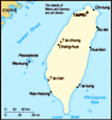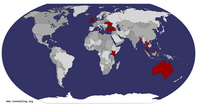COMING SOON HOUSE ADVERTISING ads_leader
They shadow our every movement, and surround us with their ethereal presence. Ghosts, according to the Taiwanese, are everywhere and you should neither fear them nor be frightened, for these ghosts are the relatives, long unshackled of their corporeal form, who are revered so greatly in Chinese culture. For one month a year they come forth from the unknown and walk the earth - unseen, unnoticed, but ever present. During this time, food is left in public places and temples as sustenance for these hungry ghosts, and prayers, incense and other generous offerings are frequent - for these ghosts are watching.
As with everything in the span of life, all eventually passes - and the ghosts must halt their earthly peregrinations and return to their rightful place in the cosmos. In order to attain this, the 14th day of the 7th lunar month is the date when the ghosts are farewelled for another year - and it is the highlight of the annual “Ghost Festival”. In Taiwan, the major focus of this occasion is held in Keelung, a short distance from Taipei. Prior to this event, I believed that the Indians were unchallenged in the noise and colour stakes when
it comes to festivals - but the Taiwanese were going to prove that they were very worth opponents.
The first part of the festival I witnessed occurred on a Sunday afternoon, the 13th day of the 7th lunar month. It was the "Procession of Dipper Lamps", where the streets play host to a parade of these lamps that not only deter evil spirits and provide ample blessings, but also represent kinship with the family’s name and destiny. Being ignorant on the location of the festivities, I immediately began searching for the celebrations upon my arrival in Keelung. No sooner had I left the train station, than I heard and saw a parade moving in my direction - what great luck and timing!
The loud noise I discerned was emanating from long Chinese brass horns that played only one note at a very loud volume - much like the droning of a million gargantuan bees - which did prove irksome after an extended period. As the floats arrived, I saw a local photographer walk amongst the parade practicing his craft, so I thought best to join him as well. I weaved amongst the moving parade and gazed at the

 The burning lanterns drift into the night
The burning lanterns drift into the night
A newly ignited lantern is in the lower portion of the photograph.garish floats which were exceptionally vibrant: some were adorned with murals and religious motifs painted in tawdry fluorescent colours, whilst others were awash in garlands of flowers and greenery. Many floats blared out different styles of music from huge speakers - everything from traditional drumming to modern techno - but all shared that incessant energetic beat.
Thinking that the parade would need to finish at some important location, but not knowing where, I deduced that the best way of reaching the end point was to follow the parade. I raced along the route which had narrowed too much for me walk along the street, so I darted through noodle stands and avoided the flailing chopsticks, scrambled across and under overpasses and underpasses, and danced around bleating sidewalk vendors. The weather conditions didn’t assist my efforts - the temperature sat in the mid-thirties with the added inconvenience of high humidity. After four kilometres of sweaty and frenetic activity, you could imagine my dismay when the main part of the parade concluded at a temple only 400 metres from my starting point.
Inside this gold-adorned temple, called the Ching-An, men carried portions of the large wooden dipper lamps that they
reassembled with must earnestness. The lamps are composed of three main parts - representing heaven, earth and mankind. The host family, who organised this parade (the festival's organisation is rotated around a dozen families in Keelung) were the first to complete this task - and the other families arrived in a flurry of noise, shouting and activity to do the same. This was probably the most important part of the day's events, as many media congregated here to capture the moment for their respective television and newspaper outlets.
How fortuitous it was that here I met Samuel (a Taiwanese journalist based in the USA) and Juliana. Being fully versed in the ways of the Ghost Festival, they informed me of the following evening's parade for the release of the water lanterns and their subsequent midnight burning at Badouzhi Harbour - such a time being chosen due to its analogy of passing between days and passing between worlds. Sensing this was an event not be missed, we agreed to meet the next night and to hopefully secure me a means of reaching the harbour, after which time Samuel would kindly drive me home - an especially grateful offer since all
public transport finished before midnight.
The next day (Monday) I finished work early and hurried to Keelung. Emerging from the train station, I discovered that the Water Lantern Parade was already building to a large event - temporary stands lined the streets, television cameras were in position, and crowds of people were arriving from all directions. I located myself in a great position opposite the official viewing area, replete with podiums and demure looking hostesses, and waited for the sun to set and the parade to begin. As the allotted time approached, the crowd swelled to an incredible size, including some silly little bald man who saw fit to continually press against me in a most uncomfortable fashion so as to get closer to the festivities. A few terse words from another spectator and a creative use of my backpack had him retreat after some time.
The purpose of this parade was to alert the ghosts that their time walking the earth was at an end, and the best method to capture the ghosts’ attention was to generate as much activity as possible. To this end, fireworks, crackers, horns, drums, speakers and other noise-emitting devices deafened the ears,
whilst streamers, dancers, acrobatic Chinese lions, and flashing lights all dazzled the eyes. Many of the floats from the previous day were in attendance, with the addition of many more - which included performances on behalf of each family. Despite the length of the parade, the enthusiasm of the participants and spectators never waned, as a continual stream of excitable Taiwanese proudly passed by.
After two hours, a typhoon brushing the coast let a gentle rain fall upon the gathering. Most people ran for shelter, but donning my rain-jacket allowed me to maintain my position, which I perceived to be a clever move. Not so, for after a few minutes, the full wrath of the typhoon was unleashed and I too sprinted into the nearest shop to avoid being totally drenched - as the last section of the parade dripped along towards a soggy end.
20 minutes later, the downpour subsided, and as the floats dispersed through the streets, I met again with Samuel and Juliana who introduced me to some of Keelung's press corps. At this time, the means of my passage to the harbour was revealed - when I was informed that it would be on
the back of a motorcycle. Perhaps a look of bemusement crossed my face, for the question, "Is this ok with you?" immediately followed. "Of course" was my reply. I really thought I was now immune to surprising news, especially since recently reading a Taiwanese cookbook, where I found the ultimate poultry recipe - "Sesame Oil Chicken Testicles". My reaction was, to say the least, most inappropriate for the hushed surrounds of a bookstore. For a gourmet like myself, nothing in life can be more surprising than photos of pink chicken's testicles in a recipe book.
The time arrived, so we needed to depart. Onto the back of a motorcycle I leapt and we headed to the harbour. Whilst hurtling along, I considered my circumstances: here I was riding on the back of a motorcycle at night, without a helmet, on wet roads, with someone I didn’t know. One part of me said “Shane, what are you doing!?”, but after my thoughts paused for a moment, the other part of me responded with enthusiasm, “Travelling!”, and I smiled, as the mild evening air rushed against my face. With the assistance of a yellow flag that gave the media access through
the road blockades, we drove past masses of people forced to walk to Badouzhi Harbour, and parked in the VIP section.
At the harbour, the celebrations were reaching their fullest expression - a massive stage was filled with drummers beating a rhythm, whilst in another section, the lanterns, which were more akin to miniature temples, were being readied for their burning. Since the ghosts’ attention was indisputably seized at the earlier parade, this was the time for fiery lanterns to illuminate a passage for the ghosts to return to the other world. These lanterns were elaborate creations with lights, paintings, decorations, and loaded with wads of ‘ghost money’ - for the burning of more ghost money ensuring wealthier ghost relatives. This currency is used for the ghosts to purchase items they may need, as evidenced by the pictures on the money of clothes, shoes, refrigerator, crockery, combs, mirrors and even an automobile. There was a great semblance between this practice and paintings in ancient Egyptian tombs, where items required in the afterlife were drawn on the walls - a most intriguing similarity.
Elsewhere, smaller airborne lanterns were being released into the sky and ghost money was tossed into

 The procession of a disassembled dipper lamp into the Ching-An Temple
The procession of a disassembled dipper lamp into the Ching-An Temple
Apologies for the lack of sharpness on this photo, but the light was poor.the ravenous bonfires - their swirling sparks dancing into the night. Though the money is burnt, it is not destroyed, for it just assumes a different form - much like the Chinese view of death itself. After the perfunctory prayers and blessings, midnight arrived and the lanterns were carried towards the foreshore. Swimmers assisted in moving them into the harbour and one by one, each lantern was put to the flame - with a subtle glow from inside the lantern suddenly erupting gloriously to consume the floating structure. As the conflagrations grew, some lanterns fitted with fireworks shot coloured sparks upwards, as the blackened frames of others collapsed into the water.
One lantern though, had floated far away from the rest and was almost beyond sight. As the flames on this final lantern extinguished, it disappeared from view and continued to its unseen destination; a sobering parallel with death itself, when the light of life dims and drifts into the blackness of the great unknown.
COMING SOON HOUSE ADVERTISING ads_leader_blog_bottom
Tot: 0.069s; Tpl: 0.015s; cc: 12; qc: 30; dbt: 0.0366s; 1; m:domysql w:travelblog (10.17.0.13); sld: 1;
; mem: 1.2mb


























angela g
non-member comment
finest effort yet
I was so rivetted by this story in my tea break that I forgot all about my cup of tea and only discovered it cold later on. As a scooter driver I have a particular fondness for moterbike travel stories. You put a smile on my face. Thanks